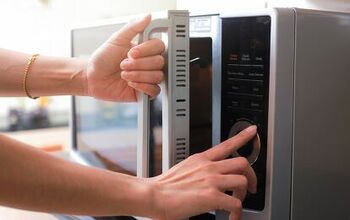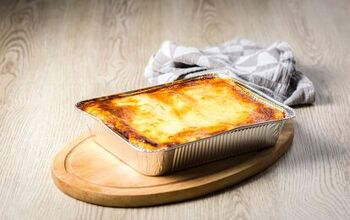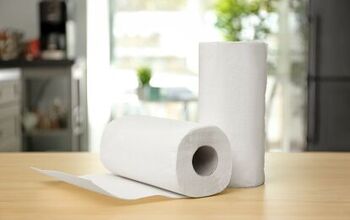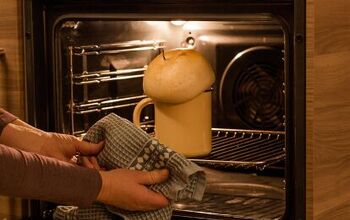Can You Put Aluminum Foil In The Oven? (Find Out Now!)

Cooking your own meals at home is a great way to learn a new trade, save some money, and find delicious flavors you enjoy. There are a plethora of kitchen hacks on the internet, many of them involving aluminum foil. It’s important to note that using aluminum foil can affect ovens in the long run.
It’s the perfect material to use for packet cooking, grilling, roasting, and even baking.
Aluminum foil can be safely put in the oven if it is not placed on the bottom. Aluminum foil is a great way to evenly cook your food hassle-free. Aluminum foil can withstand extremely high heats and only becomes toxic at 600 degrees. Its melting point is at 1,300 degrees.
I wanted to tell you everything there is to know about working with aluminum foil in the kitchen. We’ll talk about everything from the heat barrier to which appliances you can use it with. Before you know it, you’ll be baking scrumptious treats for everyone to enjoy.
Types of Aluminum Foil
If you’ve ever wondered how aluminum foil is made, it starts by passing through huge pieces of aluminum ingot through a metallic roller. The process is continued until the sheets that are left are less than 0.02cm thick. It’s a mesmerizing process to watch if you’re ever bored on Youtube.
There are two types of aluminum foil: standard and heavy-duty. The main difference between these two is the thickness. Let’s talk a bit more about the qualities of both types of aluminum foil.
Standard Aluminum Foil
Also known as thin aluminum foil, the standard version is between 0.0011 cm – 0.0018 cm thick. Many people use this type of foil to wrap leftovers, cover Tupperware containers, or make a pouch for salmon and potatoes.
Because of its thinness, it can easily tear when used with heavier items. It’s fine for things like lining a baking sheet for roasted vegetables. Standard aluminum foil should never be exposed to extreme temperatures on either end of the spectrum.
Heavy-Duty Aluminum Foil
The other type of aluminum foil is much thicker, with an average thickness of 0.02 cm – 0.04 cm. As you can tell by the name, heavy-duty aluminum foil is great for handling more intense jobs in the kitchen. Whether you need to wrap a brisket or deep freeze pastries, it can handle it.
Heavy-duty aluminum foil is a go-to material to take with you when you’re camping. It can make food cook more evenly and doesn’t give off an unpleasant metal taste.
Main Benefits of Aluminum Foil
One of the best things about both types of aluminum foil is that they’re practically the same despite their size difference. There is a release agent coated on one side to help food come off instantly. Back before this was done, people would coat the foil with shortening or butter to prevent food from sticking.
Here are some of the other great things about this popular kitchen material.
Heat Tolerance
Unlike materials such as wax paper, aluminum foil is incredibly heat resistant. It won’t break down over temperatures as parchment paper does. On the same note, it can be used in extremely cold temperatures too without cracking or breaking.
Built-In Barriers
One of my favorite things about aluminum foil is it’s a fantastic barrier. It can protect whatever’s inside from elements like air, moisture, micro-organisms, and even light. You don’t have to worry about your food coming in contact with bacteria when it’s wrapped in foil.
Thermal Conductivity
Because it’s so great in high-heat situations, it’s known for its thermal conductivity. This means that it can not only cook your food more thoroughly, but it can also speed up cooking times.
Versatility
Another awesome thing about aluminum foil is that it’s incredibly versatile. It can be used to wrap foods, polish silverware, clean your grill, and more. It makes storing leftovers easy, and you don’t have to worry about it coming unwrapped.
Reflectivity
Since aluminum foil is very reflective, it’s great at retaining heat. This can come in handy in a number of situations. Whether you’re trying to keep food warm or start a fire while you’re camping, it’s good to have aluminum foil on hand.
Food Grade
Food-grade aluminum foil that you see in stores and online today is sterile. It won’t harbor the growth of bacteria, and you don’t have to worry about a metallic taste. It’s not toxic and corrosion-resistant, making it a perfect multi-use kitchen tool.
How to Use Aluminum Foil in the Kitchen
There are many ways you can use aluminum foil in the kitchen. From everything like broiling to grilling, we’ll dive into it below. Let’s check out what you can do with this handy material.
Pouch Roasting, Baking, and Broiling
You can wrap food in little packets made from aluminum foil. This helps to lock in moisture, enhance flavors, and even prevents drying. If you want to make a foil packet, you’ll want to cut a sheet of aluminum foil big enough to cover your food.
Lay the sheet down and place your food in the center of the foil. Take the sides and double-fold the top and bottom to make a packet. Don’t crush the foil down; you want enough air inside for heat to circulate.
If you want to brown poultry, make sure there’s a small opening in the foil towards the end of the bake. You can also let the food stand in the packet for 10 minutes after cooking to make it tender and easy to slice.
Pan Roasting, Baking, and Broiling
Similarly to pouch cooking, you can also do it in a pan. This is done by lining a baking tray with aluminum foil to make cooking faster and easier. All you have to do for this is tear off the proper size piece of aluminum foil.
Then, place the foil on the underside of the baking sheet and wrap it all the way around. After you’ve done this, the whole baking sheet should be covered with aluminum foil. Press the foil tightly onto the trap before adding our food.
Barbequing
You can also barbeque with aluminum foil. By lining the grill grates with the material, you’ll be able to cook pizzas, ribs, hot dogs, potatoes, veggies, and more. You can also do this same thing with a grilling pan covered with foil.
Dealing With Sticky Foods
By now, you know that aluminum foil is practically stick-resistant. But there are a couple of things to note when working with sticky foods. This can be applied to cakes, bread, and cheeses.
These items tend to brown on the surface when in the oven. You can prevent this from happening by placing a big sheet of aluminum foil over the surface. Do this halfway through cooking to make sure everything bakes properly.
Tips, Tricks, and Notes
Whether you just moved into a new place and everything is packed, or you just don’t feel like doing dishes, aluminum foil can come in handy. You can cook a multitude of things simply by forming the foil into a cookware dish.
If you’re camping and want to cook some delicious food to keep you warm and full, use foil. All you have to do is wrap your food in the aluminum and toss it in the fire. Be sure to use tongs or stick to get the foil out when your meal is ready.
It’s not uncommon to have unique results when baking pastries with aluminum foil. An important thing to keep in mind is that cookies tend to spread more when baked on aluminum foil. Baked goods also brown more at the bottom in foil rather than on a baking sheet.
Avoid wrapping a pizza stone in aluminum foil. Pizza stones are designed to cook a specific way, and aluminum foil can interfere with that.
Related Questions
Which side of aluminum foil should touch the food?
According to Reynold’s Kitchen, the two sides of the aluminum foil are essentially the same. If you notice that one side is shiny and one is dull, you can safely cook on either one.
Is aluminum foil toxic when heated?
When aluminum foil isn’t fully inert, it can react negatively to extremely high temperatures. When it’s exposed to certain foods at these high heats, it can react once ingested. This can lead to a rare metallic build up in your blood, muscles, and organs.
At what temperature does aluminum become toxic?
If that above statement sounds scary, don’t worry; it’s rare that that happens. You can cook aluminum foil safely at the highest temperatures on a standard home oven. When it reaches 600 degrees, it will start to lose its strength, and by 1,300 degrees, it can melt.

Kirstin is a passionate writer who loves helping people learn new things when it comes to home improvement. When she's not behind a keyboard, she enjoys DIY projects, crafts, spending time with her pets, and making videos. She hopes that with all she writes, someone is finding a solution to their home improvement needs.
More by Kirstin Harrington



























